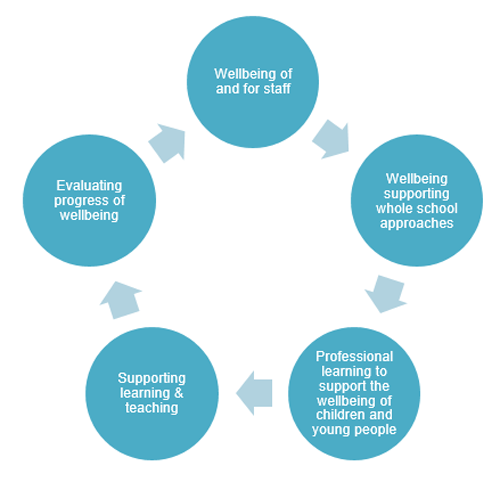The Cycle of Wellbeing

The ‘Cycle’ outlined here, provides a narrative of how the resources connect and could be used to strategically plan supports and interventions for staff and school communities, based on local evidence. It demonstrates the synergies of the resources and how they can be used strategically to forward plan supports for staff and learner mental wellbeing based on evidence gathered within a school community.
Explore this resource
The Mental health and wellbeing strategy (gov.scot) published in June 2023 sets out the long-term vision and approach to improving the mental health and wellbeing of everyone in Scotland. The vision is of a Scotland, free from stigma and inequality, where everyone fulfils their right to achieve the best mental health and wellbeing possible.
Key priorities in the strategy include reducing the risk of poor mental health and wellbeing in adult life by promoting the importance of good relationships and trauma-informed approaches from the earliest years of life, taking account where relevant adverse childhood experiences. To ensure help is available early on when there is a risk of poor mental health, and to support the physical health and wellbeing of people with mental health conditions.
This presentation provides an overview of the current context of wellbeing supports for education practitioners in Scotland.
PDF file: Cycle of Wellbeing (from Powerpoint) (317 KB)
Wellbeing of and for staff
This Wellbeing planning tool provides a traffic light warning system that staff can use to recognise if their own wellbeing may be at risk and suggests ways to manage stress. This short video provides a helpful overview Staff Wellbeing and Self Care in a Crisis on Vimeo.
This resource has been developed in collaboration with key partners across the education system. The aim is to ensure that staff across the education system feel supported, and to ensure they are able to meet the needs of our learners across the system during this challenging time.
A wide range of free professional learning has been made available for education staff to access. In addition, this Sway has been developed by colleagues at NHS Education Scotland to support staff wellbeing.
Support for staff
All staff should be supported in their roles to deliver safe, high-quality, evidence-based, relational approaches while maintaining their own resilience and wellbeing. To that end, supervision, and the use of reflective practice, is accepted good practice within the therapeutic professions. Supervision plays a critical role in the development of skills and the safe, effective delivery of psychological interventions. The ability to make use of supervision is included in the present framework. Skills associated with the delivery of supervision are detailed in a separate framework, available from the UCL Psychology and Language Sciences.
Wellbeing support
It is widely recognised that using a whole school approach helps promote positive mental wellbeing. A whole school approach can be preventative, is universal and can include targeted interventions to ensure that the needs of all members of a school community are met.
This Whole School Approach to Mental Health and Wellbeing self evaluation framework places the rights of the child at the heart of the whole school community and provides an opportunity to reflect on their own learning needs, through identifying areas of strength and areas requiring structured next steps for improvement.
The results from this self evaluation framework could be used to evidence aspects of the School Improvement Planning process.
One Good Adult
How to be a good adult (nhs.scot) sets out the 'job description' for all adults working with children and young people, as designed by children and young people from across Scotland. Educators can use this resource to reflect on where it resonates with their Professional Standards and can make meaning from this through their professional actions which are visible in their practice every day.
Professional learning to support staff
In order to ensure staff have the knowledge and skills required to support the wellbeing of children and young people, they must first identify their own professional learning needs in this area.
This Children and young people's mental health and wellbeing : a knowledge and skills framework for the Scottish workforce from NHS Education for Scotland contains the knowledge and skills required to support the mental health and wellbeing of children and young people.
It could be used as part of an individual’s Professional Review and Development (PRD) process to help identify gaps in knowledge and skills at the Informed and Skilled levels.
From this, professional learning to meet any gaps in learning can be identified.
The Children and Young People Mental Health – Professional Learning Resource is an online professional learning resource which aims to provide school staff with knowledge and understanding of mental health and wellbeing of children and young people in schools. (and can to the previously mentioned NES framework)
Further professional learning to support the wellbeing of children and young people includes:
- Compassionate and Connected Community: Professional Learning Activity (PLA) Glow login required
- Supporting children and young people through grief and loss: Professional Learning Activity (PLA) Glow login required
- Roles of middle leadership : Supporting Staff Wellbeing Role: Professional Learning Activity (PLA) Glow login required
- NES Trauma Informed - National Trauma Training Programme
- Let’s introduce anxiety management (LIAM) in early intervention: LIAM is a staged training offer intended to develop skills in the delivery of a Cognitive Behaviour Therapy (CBT) informed approach for the treatment of mild-moderate anxiety symptoms in children and young people
The mental health and wellbeing wakelet is a collection of links to materials that can be used to support the mental health and wellbeing of children and young people. It includes signposts for practitioners, parents and carers and also direct supports for children and young people to access.
Wellbeing (children and young people)
Supporting learning and teaching
A wide range of resources to support learning and teaching are available, some of the quality assured resources can be found below.
- The Compassionate and Connected Classroom (2nd Level)
- Resilience Alphabet (Early – 2nd Level)
- National e-Learning Offer
- Mental Health and Wellbeing: e-Sgoil
- Healthy Relationships - Ten Top Tips - Publications: Public Health Scotland
- The Journey (3rd/ 4th Level)
- BBC Bitesize: HWB activities (Early – 4th Level)
- HWB activities (Early – 4th Level)
These ‘Talking Mental Health’ (primary) and ‘We all Have Mental Health’ (secondary) animations are universal resources for primary school pupils and have accompanying materials for lessons, assemblies and role play sessions. These are freely available for use in Scottish schools.
Evaluating progress of wellbeing
There is an expectation for all areas of the curriculum that progress will be evidenced through the levels using the Experiences and Outcomes and the Benchmarks.
However, with mental, emotional, social & physical (MESP) the Experiences and Outcomes of fall within Responsibility of All. Here, progress is evaluated on a regular basis as progression is not linear and wellbeing fluctuates from day to day, week to week, month to month and as a result there are no progressive Benchmarks for Responsibility of All.
A wide range of tools are available to help evaluate the progress of learners.
This helpful Learner Wellbeing Matrix developed by The West Partnership provides a helpful overview of a range of tolls to help evaluate progress in wellbeing, both for identifying universal and targeted needs.
Specifically, the Glasgow Motivation and Wellbeing Profile (GWWP) has been used widely and provides and easy to use 20 item questionnaire that explores motivation and wellbeing in a learning context. It can also be used to identify next steps for individuals, whole class or whole school interventions and provide opportunities to measure progress of specific interventions over time.
